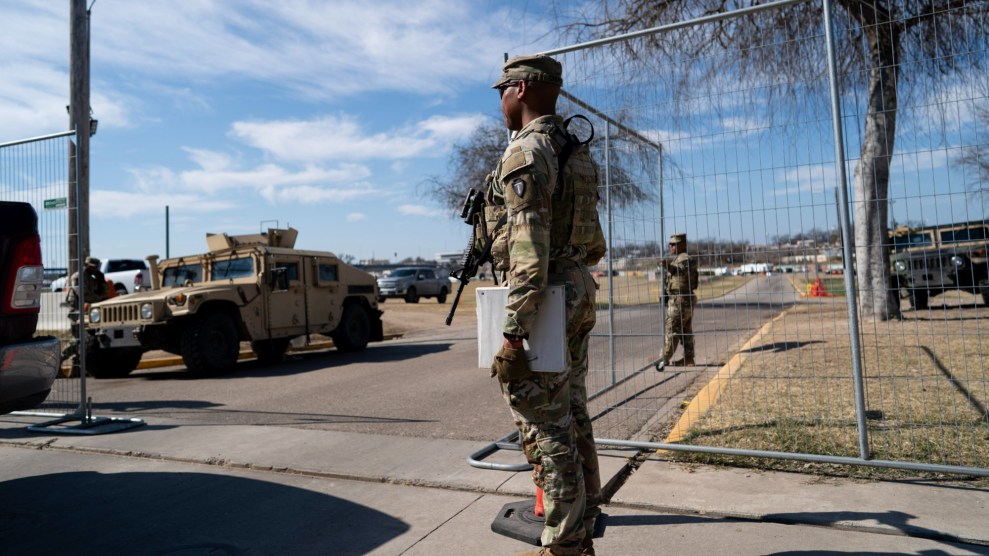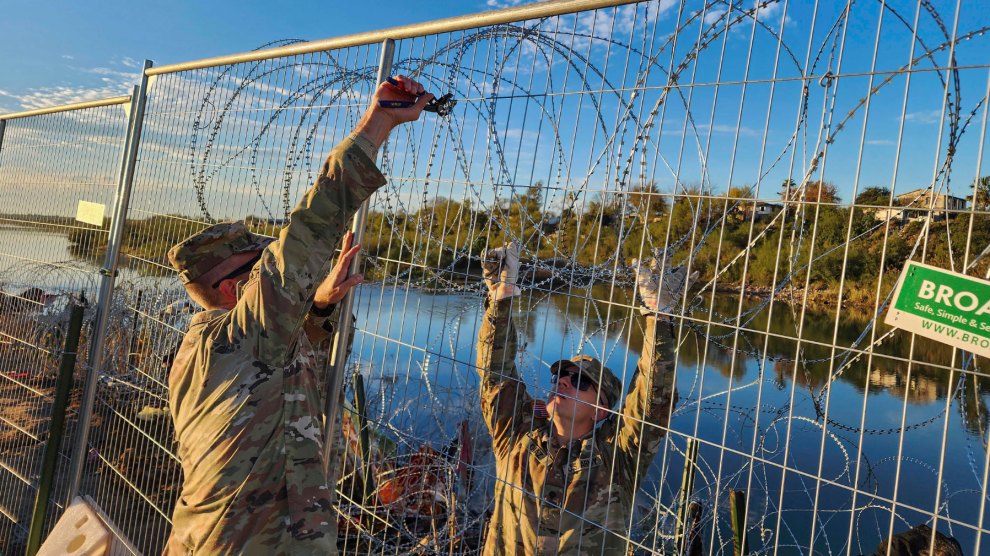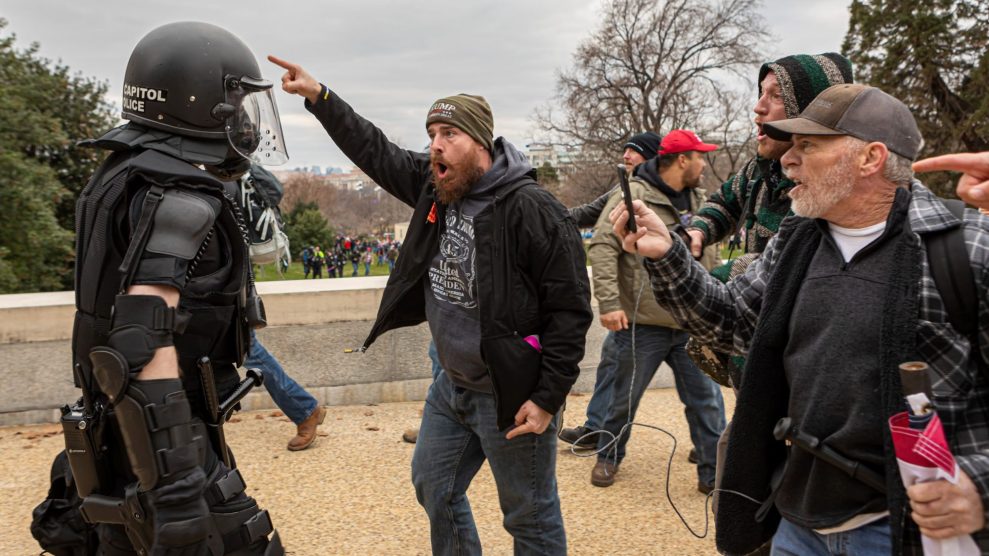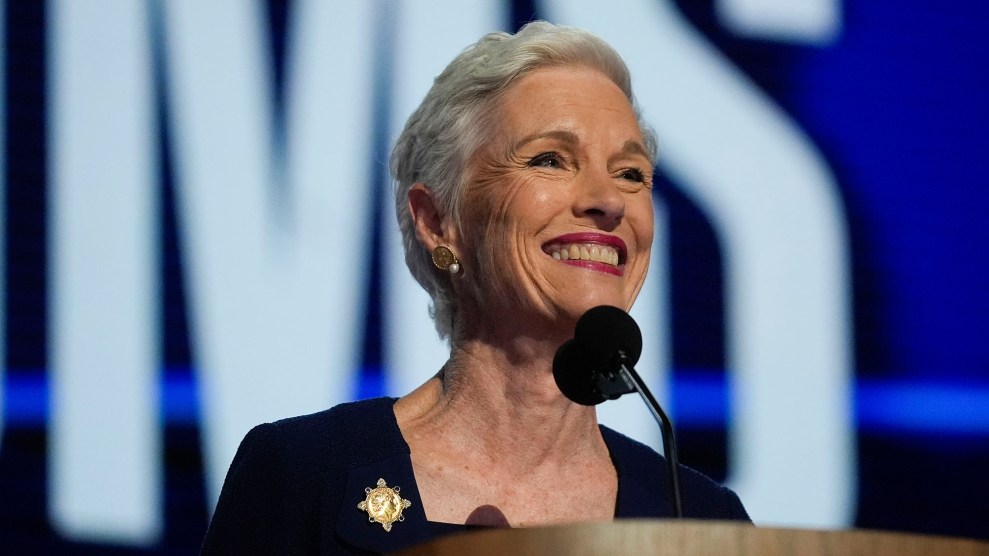
Members of the Texas National Guard on duty in Eagle Pass. Liu Jie/Xinhua/ZUMA
Joshua Rubin, a Brooklyn software developer and founder of the pro-immigrant grassroots group Witness at the Border, spent his 72nd birthday in Eagle Pass, Texas. He gathered with another half a dozen volunteers at the border town across from Mexico’s Piedras Negras for a two-week vigil “to, according to the organization, “stand up against [Governor] Greg Abbott’s racist and inhumane regime,”
They carried vinyl banners that read “Justice for Migrants” and “Give Back Shelby Park,” a reference to the 47-acre field on the banks of the Rio Grande named after a Confederate general that Abbot and his $10 billion Operation Lone Star have turned into a razor wire-enclosed outpost for Texas state forces. On the Mexico side, a sign in Spanish warns potential crossers of the dangers of the floating barrier made of buoys with sharp metal disks between them: “People have died; look for another path, please.”
“There’s so much concertina here, I don’t think they’ll ever be able to rescue the river,” Rubin says of the wire-fencing Gov. Abbott put up along the Rio Grande to prevent migrants from crossing. “It’s quite something to see.” Another sight to behold is the militarized presence of a plethora of law enforcement agencies crowding that sliver of the 2,000-mile long US-Mexico border. Besides US Customs and Border Protection (CBP) and the Texas National Guard, state troopers from as far away as Florida and Missouri have been sent to deal with the supposed “invasion” decried by Republican governors. But in the face of a decrease in migrant crossings, these heavily armed law enforcement personnel are finding little in the form of an enemy to fight.
“We stand here, we watch and we tell the immigrants to turn around,” a Louisiana soldier dressed in body armor told NOLANews. If a migrant manages to come through the barrier, they contact the Texas Department of Public Safety (TDPS) which then calls CBP. “They’re running up and down the river on airboats,” Rubin says. “They don’t have much to do at all. There’s not a lot going on.”
Migrant encounters with US law enforcement in the Del Rio sector, which includes Eagle Pass, peaked in December at 71,000, but have slowed dramatically since then. In March, those encounters dropped to 11,000. Gov. Abbot and the TDPS have taken credit for the sharp drop. “Our stiff resistance is working,” the Texas governor wrote on X in February. But experts and US government officials say the changes have less to do with Texas than with seasonal migratory patterns and more strict crackdowns from Mexico.
“It’s interesting to hear the state of Texas taking credit for the decrease when so much of its security presence in Eagle Pass now also existed in December,” one Department of Homeland Security official told the Washington Post. Mexico, Rubin says, is “doing the work Greg Abbott is taking credit for.”
Eagle Pass, the seat of Maverick County, has emerged as the epicenter of a political and constitutional standoff between Texas and the federal government. Last year, Texas sued the Biden administration after Border Patrol agents cut parts of the concertina wire to respond to medical emergencies, claiming the cutting “disrupted the State’s border security efforts.” In a 5-4 vote, the Supreme Court decided in favor of the Biden administration, allowing federal officials to remove parts of the barrier. That same month, three migrants—a woman and two children—drowned after the Texas National Guard seized control of Shelby Park and prevented US Border Patrol, which conducts migrant rescues, from accessing the area.
Maverick County has seen a record number of migrant deaths, resulting in a shortage of body bags and corpses being left in fridges for months, the Washington Post recently reported. In 2022, CBP reported 895 migrant deaths at the southern border—256 were in the Del Rio sector, more than any other area.
Meanwhile, the Texas Military Department is building a massive 80-acre base camp near Eagle Pass to hold up to 2,300 members of the National Guard that could cost taxpayers as much as $500 million. Troops will have access to a dining facility serving chef-prepared and buffet style meals, a fitness center, and basketball and volleyball courts, according to a contractor’s proposal reviewed by the Texas Observer. During the vigil, Rubin and other volunteers got a glimpse of the under-construction site, but they were told to leave the premises. From what he could gather, “it’s a very unpleasant place,”

















